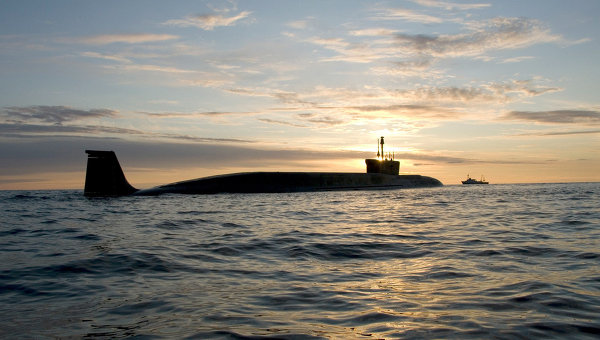
Dostoevsky Doctrine Dominates Russian Naval Planning
Publication: Eurasia Daily Monitor Volume: 10 Issue: 208
By:

Recent statements by Russia’s naval top brass concerning highly ambitious plans to develop sixth-generation warfare capabilities at sea and to shortly introduce another Borey-class submarine run contrary to the long-term narrative of decline in Russian naval power. The author recalls asking a leading specialist on the Russian Navy what materials may be consulted to better understand this aspect of the country’s military, to which came the reply “read Dostoevsky!” Indeed, the works of the 19th century Russian literary giant Fyodor Dostoevsky contain ample amounts of dreaming on the part of his characters; but the level of fictional dreaming inherent in Russian naval development policy never ceases to break new ground (Interfax, November 13).
On November 13, the commander-in-chief of the Navy, Admiral Viktor Chirkov, addressed a shipbuilding conference and outlined long-term plans to 2050 to arm Russian warships with “long-range precision guided weapons.” Chirkov explained that the Navy must be involved in the Armed Forces’ system of “active global defense” and be able to respond to an “instantaneous global strike from oceans and seas.” The defense minister, Army-General Sergei Shoigu, recently outlined the three main future threats to Russian national security: post-2014 Afghanistan and international terrorism: the expansion of the North Atlantic Treaty Organization (NATO); and energy competition in the Arctic (see EDM, November 14). The Russian naval commander, meanwhile, talked about the need for the creation of “general purpose navy forces,” armed with “long-range accuracy weapons.” The main requirement, he continued, is the creation of a “deterrence potential” to stop “military dangers from seas and oceans from deteriorating into “threats of war,” and preventing conflicts from erupting (Interfax, November 13). Such naval capabilities clearly have nothing to do with countering international terrorism; but they do reflect very real concerns about conflict escalation and de-escalation.
Military experts in Moscow tried to make sense of Chirkov’s statements. One unidentified expert told Interfax that the naval commander may have in mind arming missile ships and multipurpose submarines with cruise missiles with ranges of between 5,000 kilometers to 6,000 kilometers or with other intercontinental-range systems. Whatever the intended message concerning naval rearmament plans, Chirkov did little to clarify his vision of non-nuclear deterrence and the promotion of naval sixth-generation warfare capabilities in the context of an ailing defense industry with limited shipbuilding and modernization capacity (Interfax, RIA Novosti, November 13).
However, Chirkov told his audience that the Navy may receive its first ship built on the basis of the “modular principle” sometime from 2018 to 2020. “In the process of the implementation of the long-term shipbuilding program, new ships for the Navy should be built in accordance with the modular principle. We require this as a customer. The Navy could receive its first ship built in accordance with this principle in 2018–2020,” Chirkov said. Using pre-fabricated blocks will speed up design work and lower production costs. A “modular ship” will implement tasks currently assigned to several ships of a differing class. Chirkov explained that the “modular” approach may be applied to power-generating units, communications, navigation and weapons systems, adding that the “modular principle” will soon be tested on a small corvette (Interfax, RIA Novosti, November 13).
Puzzling statements have also emerged concerning the fate of the Bulava (SS-NX-30) submarine-launched ballistic missiles (SLBM) and the Borey-class nuclear-powered ballistic missile submarines (SSBN); no more tests will be conducted on the former until next year, while the latter could enter service shortly (RIA Novosti, November 13). The two are intimately connected as the Borey SSBNs were designed with launch tubes specifically for the troubled Bulava SLBM. While six test launches are planned for the Bulava commencing in summer 2014, the news for Borey submarines in the hiatus appears contradictory; according to Interfax, the Aleksandr Nevskiy has completed its state trials, and its handover to the Russian navy is imminent (IRAT-TASS, November 14; Interfax-AVN, November 8).
The Aleksandr Nevskiy is the first serial-production submarine of project 955 (Borey); the lead vessel, Yuriy Dolgorukiy, entered service with the Navy in early 2013. The Nevskiy, following some final fittings based on recommendations from the state acceptance commission, is expected to enter service in late November or early December (https://www.oaoosk.ru/news1830.html#newsname_1830). Admiral Chirkov said that construction work will begin in 2014 on a fifth Borey submarine, though he seemed uncertain as to the exact date involved (Interfax, November 13).
In early November, sources in the Navy Main Staff suggested that Borey SSBNs would not be used in the Navy in a multipurpose role. The sources argued that using Borey submarines in such a role, without being armed with 16 Bulava missiles, was akin to trying to deploy Tu-160 strategic bombers as fighter aircraft (ITAR-TASS, November 1). However, the General Staff, the Ministry of Defense and the Navy Command seem to disagree on the possible role of Borey submarines pending a solution to the Bulava problems. The entrance of Borey-class submarines into service, experimentally as some sources suggest, implies that these vessels will be in a type of limbo—neither fully in service nor out. One precedent appears to exist: the obscure status of the Sankt-Petersburg, the first Lada-class (Project 677) diesel submarine, which operates experimentally in the Northern Fleet (RIA Novosti, November 1).
Whatever the precise status may be of the Borey-class submarines entering the Russian Navy, in the absence of the Bulava SLBM, the entire process is a near national embarrassment that shows no sign of a speedy resolution. In this context, like his predecessors with their unrealistic talk of building several aircraft carriers, Chirkov has resorted to offering dreams of a sixth-generation capability at sea by 2050 to deflect attention from the serious crisis in planning and force development facing Russia’s Navy. Dostoevsky-style dreams may pass for policy plans among some senior naval officers, but there is no escaping the sharp contrast between such highly ambitious announcements and the reality of the ongoing dilemma over Bulava.




